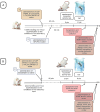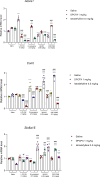Antidepressant effects of selective adenosine receptor antagonists targeting the A1 and A2A receptors administered jointly with NMDA receptor ligands: behavioral, biochemical and molecular investigations in mice
- PMID: 39048810
- PMCID: PMC11387455
- DOI: 10.1007/s43440-024-00627-z
Antidepressant effects of selective adenosine receptor antagonists targeting the A1 and A2A receptors administered jointly with NMDA receptor ligands: behavioral, biochemical and molecular investigations in mice
Abstract
Background: The objective of the study was to ascertain the antidepressant potential of the co-administration of NMDA receptor ligands and selective adenosine A1 and A2A receptor antagonists.
Methods: The forced swim test (FST) and spontaneous locomotor activity test were carried out in adult male naïve mice. Before the behavioral testing, animals received DPCPX (a selective adenosine A1 receptor antagonist, 1 mg/kg) or istradefylline (a selective adenosine A2A receptor antagonist, 0.5 mg/kg) in combination with L-701,324 (a potent NMDA receptor antagonist, 1 mg/kg), D-cycloserine (a partial agonist at the glycine recognition site of NMDA receptor, 2.5 mg/kg), CGP 37849 (a competitive NMDA receptor antagonist, 0.3 mg/kg) or MK-801 (a non-competitive NMDA receptor antagonist, 0.05 mg/kg). Additionally, serum BDNF level and the mRNA level of the Adora1, Comt, and Slc6a15 genes in the murine prefrontal cortex were determined.
Results: The obtained results showed that DPCPX and istradefylline administered jointly with NMDA receptor ligands (except for DPCPX + D-cycloserine combination) produced an antidepressant effect in the FST in mice without enhancement in spontaneous motility of animals. An elevation in BDNF concentration was noted in the D-cycloserine-treated group. Adora1 expression increased with L-701,324, DPCPX + D-cycloserine, and DPCPX + CGP 37849, while D-cycloserine, CGP 37849, and MK-801 led to a decrease. Comt mRNA levels dropped with DPCPX + L-701,324, istradefylline + L-701,324/CGP 37849 but increased with D-cycloserine, MK-801, CGP 37849 and DPCPX + MK-801/ CGP 37849. Slc6a15 levels were reduced by D-cycloserine, DPCPX + L-701,324 but rose with DPCPX + CGP 37849/MK-801 and istradefylline + D-cycloserine/MK-801/CGP 37849.
Conclusion: Our study suggests that selective antagonists of adenosine receptors may enhance the antidepressant efficacy of NMDA receptor ligands highlighting a potential synergistic interaction between the adenosinergic and glutamatergic systems. Wherein, A2A receptor antagonists are seen as more promising candidates in this context. Given the intricate nature of changes in BDNF levels and the expression of Adora1, Comt, and Slc6a15 seen after drug combinations exerting antidepressant properties, further research and integrative approaches are crucial understand better the mechanisms underlying their antidepressant action.
Keywords: BDNF; DPCPX; Forced swim test; Gene expression; Istradefylline; NMDA receptor ligands.
© 2024. The Author(s).
Conflict of interest statement
The authors confirm that they have no conflicts of interest.
Figures




Similar articles
-
The Interaction of Selective A1 and A2A Adenosine Receptor Antagonists with Magnesium and Zinc Ions in Mice: Behavioural, Biochemical and Molecular Studies.Int J Mol Sci. 2021 Feb 12;22(4):1840. doi: 10.3390/ijms22041840. Int J Mol Sci. 2021. PMID: 33673282 Free PMC article.
-
Agomelatine and tianeptine antidepressant activity in mice behavioral despair tests is enhanced by DMPX, a selective adenosine A2A receptor antagonist, but not DPCPX, a selective adenosine A1 receptor antagonist.Pharmacol Rep. 2019 Aug;71(4):676-681. doi: 10.1016/j.pharep.2019.03.007. Epub 2019 Mar 16. Pharmacol Rep. 2019. PMID: 31200233
-
Antidepressant activity of the adenosine A2A receptor antagonist, istradefylline (KW-6002) on learned helplessness in rats.Psychopharmacology (Berl). 2014 Jul;231(14):2839-49. doi: 10.1007/s00213-014-3454-0. Epub 2014 Feb 2. Psychopharmacology (Berl). 2014. PMID: 24488405
-
Involvement of adenosine A2A receptors in depression and anxiety.Int Rev Neurobiol. 2014;119:373-93. doi: 10.1016/B978-0-12-801022-8.00015-5. Int Rev Neurobiol. 2014. PMID: 25175973 Review.
-
Adenosine A2A receptors in ventral striatum, hypothalamus and nociceptive circuitry implications for drug addiction, sleep and pain.Prog Neurobiol. 2007 Dec;83(5):332-47. doi: 10.1016/j.pneurobio.2007.04.002. Epub 2007 May 1. Prog Neurobiol. 2007. PMID: 17532111 Free PMC article. Review.
Cited by
-
Arginine Metabolism and Adenosine Receptor Signals in the Cerebellum Contribute to Nicotine Withdrawal-Induced Anxiety/Depression-Like Behaviours.Addict Biol. 2025 Aug;30(8):e70076. doi: 10.1111/adb.70076. Addict Biol. 2025. PMID: 40735940 Free PMC article.
References
-
- Institute of Health Metrics and Evaluation Global Health Data Exchange (GHDx). http://ghdx.healthdata.org/gbd-results-tool?params=gbd-api-2019-permalin....
MeSH terms
Substances
Grants and funding
LinkOut - more resources
Full Text Sources
Medical
Miscellaneous
